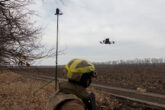January 10, 2022
Spiking the Problem: Developing a Resilient Posture in the Indo-Pacific With Passive Defenses
This article originally appeared in War on the Rocks.
In the late 1960s, U.S. Air Force Gen. Glenn Kent found a unique but effective way to overcome persistent resistance from Defense Department colleagues to building base defenses in Europe. During heated budget battles, Air Force officers habitually prioritized new aircraft and missiles over purely defensive measures. Gen. William “Spike” Wallace Momyer, commander of U.S. Tactical Air Forces, had written on a piece of paper that his top priority was to build hardened aircraft shelters to protect American fighter aircraft based in Europe from Soviet attack. Kent then obtained the Air Force chief of staff’s concurrence, which was captured by his signature under the phrase “I’m with Spike.” Kent or a colonel attended every meeting as the Air Force built its budget and each time eliminating funding for the shelters was proposed, he pulled out that piece of paper and said, “I’m with Spike.”
America’s military posture, which is comprised of forces, bases, and agreements, is a critical issue that needs a senior champion
This level of senior leader guidance and continuous engagement was needed to ensure that short-range American airpower — a key U.S. advantage — could have been effectively employed to stop a Soviet invasion, thereby strengthening deterrence.
Today, America’s military posture, which is comprised of forces, bases, and agreements, is a critical issue that needs a senior champion. China has a formidable arsenal of conventionally armed long-range missiles that are significantly more accurate than the ones that the Soviet Union had during the Cold War and plans to fire them in a first strike to destroy U.S. forces on the land and at sea. The Defense Department should ensure that American forces in the Indo-Pacific can survive this blow and generate combat power while under attack, which requires taking steps to increase the resiliency of U.S. military posture.
Read the full article from War on the Rocks.
More from CNAS
-
Defense / Transatlantic Security
When Defense Becomes Destruction: Austria-Hungary’s Mistake and Ukraine’s RiskThis article was originally posted on War on the Rocks. The southeastern Polish city of Przemyśl, with its elegant 19th century Habsburg-era train station, remains one of the ...
By Franz-Stefan Gady
-
Defense / Transatlantic Security
Ukraine’s Catch-22 MomentThis article was originally published in the Financial Times. In Joseph Heller’s wartime classic, Catch-22, the protagonist Yossarian seeks out the US army surgeon Doc Daneeka...
By Franz-Stefan Gady
-
CNAS Insights | Budgetary Own Goals Undermine “Speed and Volume”
On November 7, Secretary of Defense Pete Hegseth laid out a plan to overhaul the Department of Defense’s (DOD’s) acquisition system. Placing an emphasis on delivering new capa...
By Philip Sheers, Carlton Haelig & Stacie Pettyjohn
-
Drones: Who Is Making the New Weapons of War?
From Ukraine and Russia to Gaza and Sudan, drones have become a key weapon of war. Which companies are making them, and profiting from this rapidly expanding but controversial...
By Stacie Pettyjohn




